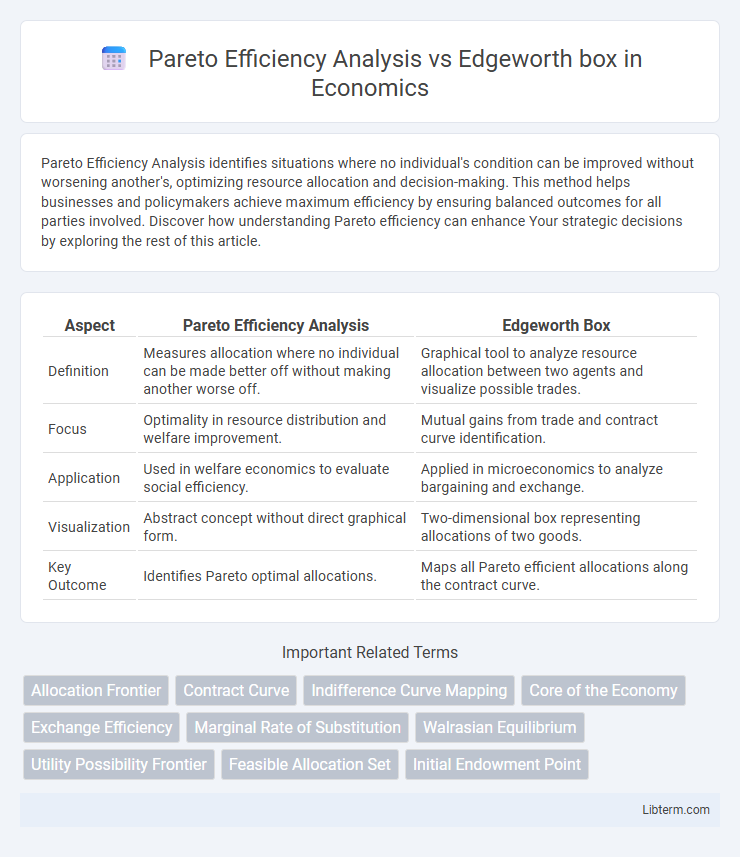Pareto Efficiency Analysis identifies situations where no individual's condition can be improved without worsening another's, optimizing resource allocation and decision-making. This method helps businesses and policymakers achieve maximum efficiency by ensuring balanced outcomes for all parties involved. Discover how understanding Pareto efficiency can enhance Your strategic decisions by exploring the rest of this article.
Table of Comparison
| Aspect | Pareto Efficiency Analysis | Edgeworth Box |
|---|---|---|
| Definition | Measures allocation where no individual can be made better off without making another worse off. | Graphical tool to analyze resource allocation between two agents and visualize possible trades. |
| Focus | Optimality in resource distribution and welfare improvement. | Mutual gains from trade and contract curve identification. |
| Application | Used in welfare economics to evaluate social efficiency. | Applied in microeconomics to analyze bargaining and exchange. |
| Visualization | Abstract concept without direct graphical form. | Two-dimensional box representing allocations of two goods. |
| Key Outcome | Identifies Pareto optimal allocations. | Maps all Pareto efficient allocations along the contract curve. |
Introduction to Pareto Efficiency
Pareto Efficiency, a fundamental concept in economics, refers to an allocation where no individual can be made better off without making someone else worse off, serving as a benchmark for optimal resource distribution. The Edgeworth box visually represents the allocation of two goods between two agents, illustrating potential Pareto improvements through contract curves. Understanding Pareto Efficiency helps analyze trade-offs and efficiency in economic exchanges within the Edgeworth box framework.
Understanding the Edgeworth Box
The Edgeworth box graphically represents the distribution of resources between two individuals, illustrating all possible allocations within a fixed total endowment. It helps identify Pareto efficient points where no reallocation can make one party better off without harming the other, forming the contract curve. Understanding the Edgeworth box is essential for analyzing mutual gains from trade and bargaining outcomes in microeconomic theory.
Key Concepts in Pareto Analysis
Pareto Efficiency Analysis identifies allocations where no individual can be made better off without making someone else worse off, emphasizing optimal resource distribution. The Edgeworth box visually represents these allocations, showing possible trades between two agents and highlighting the contract curve of Pareto efficient states. Key concepts in Pareto Analysis include efficiency frontier, Pareto improvements, and the indistinguishability of outcomes that maximize collective well-being.
Visualizing Allocations with Edgeworth Box
Visualizing allocations with the Edgeworth box provides a graphical representation of resource distribution between two agents, highlighting all possible allocations within a fixed total endowment. Pareto efficiency analysis identifies the set of points inside the Edgeworth box where no individual can be made better off without making the other worse off, known as the contract curve. This visualization aids in understanding mutually beneficial trade-offs and the potential for Pareto improvements in resource allocation.
Criteria for Pareto Optimality
Pareto Efficiency Analysis determines an allocation as Pareto optimal if no individual's situation can be improved without worsening another's, emphasizing efficiency in resource distribution. The Edgeworth box graphically represents the set of allocations and identifies points where the contract curve satisfies Pareto optimality criteria, showing mutually beneficial trades. Criteria for Pareto optimality include no further possible Pareto improvements within the feasible set, demonstrated by tangency of indifference curves inside the Edgeworth box and zero net gains from reallocation.
Role of Indifference Curves in Edgeworth Box
Indifference curves in the Edgeworth box represent combinations of goods between two agents that yield equal utility, playing a crucial role in identifying allocations where no agent can be made better off without making the other worse off. These curves illustrate the set of Pareto efficient points by showing the tangency of preferences between agents, marking equilibrium where marginal rates of substitution are equal. This visual tool facilitates the analysis of mutually beneficial trades and the core concept of Pareto efficiency in exchange economies.
Comparative Analysis: Pareto Efficiency vs Edgeworth Box
Pareto Efficiency Analysis identifies allocations where no individual can be made better off without making another worse off, serving as a criterion for optimal resource distribution. The Edgeworth Box graphically represents all possible allocations between two agents and visually locates the contract curve where Pareto efficient outcomes lie. Comparative analysis shows that while Pareto Efficiency provides a quantitative benchmark, the Edgeworth Box offers an intuitive, visual tool for understanding trade-offs and mutual gains in two-agent exchange economies.
Real-World Applications of Both Tools
Pareto Efficiency Analysis is widely applied in resource allocation within healthcare, economics, and public policy to identify optimal distributions where no individual can be made better off without making another worse off. The Edgeworth Box is extensively used in international trade and market equilibrium studies to visualize and analyze efficient allocations and potential gains from trade between two agents with differing preferences. Both tools facilitate real-world decision-making by illustrating efficiency and mutual benefit in diverse economic and strategic negotiations.
Limitations of Pareto and Edgeworth Approaches
Pareto Efficiency Analysis fails to address the distributional fairness and can result in multiple efficient outcomes without indicating the most equitable solution. The Edgeworth box approach, while visually representing contractual exchanges and mutual gains, is limited by its assumption of two-agent, two-good models, which oversimplifies complex multi-agent economies. Both methods overlook dynamic considerations such as time-dependent preferences and market imperfections, restricting their practical applicability in real-world economic analysis.
Conclusion: Choosing the Right Analytical Framework
Pareto Efficiency Analysis offers a clear measure of resource allocation where no individual can be made better off without making someone else worse off, ideal for evaluating optimality in economic models. The Edgeworth box provides a graphical representation of potential trades and the contract curve, enabling visualization of mutually beneficial exchanges between two agents. Selecting the appropriate framework depends on the complexity of the economic interaction and the need for either quantitative efficiency assessment or qualitative insights into bargaining and trade.
Pareto Efficiency Analysis Infographic

 libterm.com
libterm.com